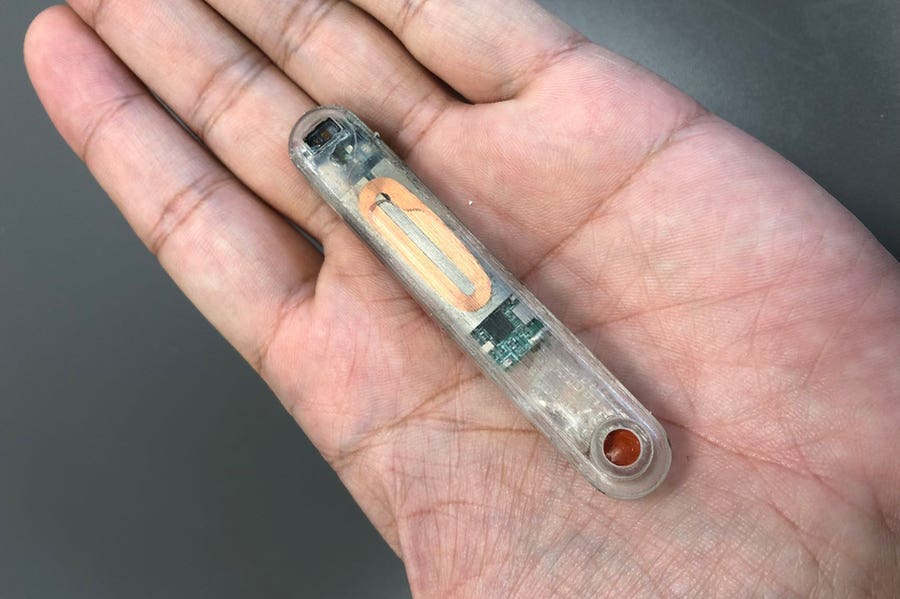Lifesaving implantable sensor reverses opioid overdoses
This technology could become a critical tool in preventing overdose deaths, particularly among individuals who have previously survived an overdose.

The device, roughly the size of a stick of gum, is designed to be implanted under the skin, where it can continuously monitor vital signs such as heart rate and breathing. (CREDIT: MIT)
In 2023, over 100,000 Americans lost their lives to opioid overdoses. The most effective way to save someone in the midst of an overdose is by administering a drug called naloxone. However, getting naloxone to an overdose victim in time is often a challenge. First responders or bystanders aren’t always nearby, and precious moments can slip away before help arrives.
To tackle this urgent issue, researchers at MIT and Brigham and Women’s Hospital have developed a new device that could revolutionize the way overdoses are treated. The device, roughly the size of a stick of gum, is designed to be implanted under the skin, where it can continuously monitor vital signs such as heart rate and breathing. If the device detects signs of an overdose, it swiftly administers a dose of naloxone, potentially saving a life.
The development of this device was detailed in a study published in the journal Device, where the researchers demonstrated that it could successfully reverse overdoses in animal models. With further refinement, this technology could become a critical tool in preventing overdose deaths, particularly among individuals who have previously survived an overdose.
“This could really address a significant unmet need in the population that suffers from substance abuse and opiate dependency to help mitigate overdoses, with the initial focus on the high-risk population,” says Giovanni Traverso, an associate professor of mechanical engineering at MIT, gastroenterologist at Brigham and Women’s Hospital, and the study's senior author.
Naloxone is a powerful opioid antagonist, meaning it can bind to opioid receptors and block the effects of drugs like heroin and fentanyl. Administered through injection or nasal spray, naloxone can restore normal breathing within minutes. Yet, many overdose victims are alone when they need it most, unable to receive timely help. This is especially concerning with the rise of synthetic opioids, which are more potent and cause overdoses that are both rapid and unpredictable.
While some researchers are exploring wearable devices that could detect an overdose and deliver naloxone, these devices have not yet proven successful. The team at MIT and Brigham and Women’s Hospital took a different approach by designing an implantable device. Their goal was to create something less bulky and more reliable—one that doesn’t require the patient to remember to wear it.
The device they developed is equipped with sensors that monitor heart rate, breathing rate, blood pressure, and oxygen saturation. In their animal studies, the researchers used these sensors to track how these vital signs change during a fentanyl overdose. This data allowed them to develop a unique algorithm that enhances the device’s ability to accurately detect an opioid overdose while distinguishing it from other conditions like sleep apnea.
Related Stories:
The research revealed that during a fentanyl overdose, heart rate drops first, followed closely by a decrease in breathing rate. By analyzing these changes, the researchers could pinpoint the exact moment when naloxone should be administered.
“The most challenging aspect of developing an engineering solution to prevent overdose mortality is simultaneously addressing patient adherence and willingness to adopt new technology, combating stigma, minimizing false positive detections, and ensuring the rapid delivery of antidotes,” explains Hen-Wei Huang, a former MIT visiting scientist and current assistant professor at Nanyang Technological University in Singapore. “Our proposed solution tackles these unmet needs by developing a miniaturized robotic implant equipped with multisensing modalities, continuous monitoring capabilities, on-board decision making, and an innovative micropumping mechanism.”
The device also features a small reservoir capable of holding up to 10 milligrams of naloxone. Once an overdose is detected, the device activates a pump that dispenses the naloxone, delivering it within about 10 seconds. In their animal studies, the researchers observed that this method successfully reversed the effects of an overdose 96 percent of the time.
“We created a closed-loop system that can sense the onset of the opiate overdose and then release the antidote, and then you see that recovery,” Traverso notes.
Looking ahead, the researchers believe this technology could become a lifeline for those at the highest risk of overdose, particularly those who have already experienced one. They plan to continue refining the device, focusing on making it as user-friendly as possible. This includes determining the optimal location for implantation to maximize effectiveness and comfort.
“A key pillar of addressing the opioid epidemic is providing naloxone to individuals at key moments of risk. Our vision for this device is for it to integrate into the cascade of harm-reduction strategies to efficiently and safely deliver naloxone, preventing death from opioid overdose and providing the opportunity to support individuals with opioid use disorder,” says Peter Chai, an associate professor of emergency medicine at Brigham and Women’s Hospital.
The next step for the research team is to test the device in human trials, which they hope to begin within the next three to five years. Meanwhile, they are working on further miniaturizing the device and optimizing its battery life, which currently lasts for about two weeks.
This groundbreaking research has been supported by funding from Novo Nordisk, the McGraw Family Foundation at Brigham and Women’s Hospital, and the MIT Department of Mechanical Engineering. With continued development and successful human trials, this device could represent a significant advance in the fight against the opioid crisis, offering a new layer of protection for those most at risk.
Note: Materials provided above by The Brighter Side of News. Content may be edited for style and length.
Like these kind of feel good stories? Get The Brighter Side of News' newsletter.
Rebecca Shavit
Science & Technology Journalist | Innovation Storyteller
Based in Los Angeles, Rebecca Shavit is a dedicated science and technology journalist who writes for The Brighter Side of News, an online publication committed to highlighting positive and transformative stories from around the world. With a passion for uncovering groundbreaking discoveries and innovations, she brings to light the scientific advancements shaping a better future. Her reporting spans a wide range of topics, from cutting-edge medical breakthroughs and artificial intelligence to green technology and space exploration. With a keen ability to translate complex concepts into engaging and accessible stories, she makes science and innovation relatable to a broad audience.



